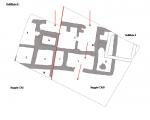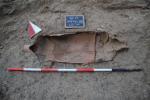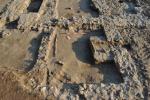Summary (English)
Two buildings were uncovered in trenches CXI and CXII, I and L, one probably dating to the early 1st century A.D., and a later one that incorporated the preceding structure. The later building dates to between the end of the 1st /early 2nd century A.D. and the 6th/7th century A.D. (fig. 1).
Trench CXI occupies the southern sector of the area; during this campaign, the investigations concentrated on the eastern sector of the trench.
In room 1, situated in the north-eastern part of the trench, a cobblestone floor was excavated, dated by the finds to the end of the 1st – early 2nd century A.D., symmetrical with the floor in the adjacent room. In a first phase, these rooms constituted a single space that was divided sometime between the 3rd and 4th centuries A.D. (fig. 2). A new room (8) was identified in the north-eastern part of the trench, probably added to the main body of the structure in the mid 2nd century A.D. It had a door on the east side and the floors date to between the late 2nd and the first half of the 3rd century A.D.A small necropolis was uncovered in the south-eastern sector. On an east-west alignment, it presented earth graves and “a cappuccina” burials. In addition to the burials excavated in previous seasons, four more burials, of which two in amphorae were dug this year. The first enchytrismós was formed by two Tunisian amphorae (fig. 3), dating the burial to the first half of the 6th century A.D. The second burial was inside a single amphora, probably a Keay 62 type.
Trench CXII occupied the northern part of the area; during this season investigations were carried out across the whole trench.In building I, two small bread ovens were identified (fig. 4), cut into the beaten floor surface of the room. Test pits dug in the floor provided evidence showing that the wall dividing the room in two was built in the mid 2nd century A.D. The floors in rooms 6 and 7 and the area outside room 6 were investigated, the finds dating them to between the final years of the 1st and the early 2nd century A.D. There was a large hole in the floor of room 6, caused by the collapse of a section of an opus latericium wall.
Inside room 6, the excavation continued of the fill inside the small exedra, which dated its abandonment to the period between the mid 6th century and early 7th century A.D. The investigations (to be completed) revealed the absence of opus signinum in the structure, initially interpreted as a small cistern. The excavation of room 5 (fig. 5) revealed a series of walls that divided the space, whose function remains to be clarified.
- F. Bulzomì - Università di Pisa Dipartimento di Civiltà e Forme del Sapere
- Stefano Genovesi – Università degli Studi di Pisa, Dipartimento di Civiltà e Forme del Sapere
- Paolo Sangriso – Università degli Studi di Pisa, Dipartimento di Civiltà e Forme del Sapere.
Director
- Simonetta Menchelli - Università degli Studi di Pisa Dipartimento di Civiltà e Forme del Sapere.
Team
Research Body
- Università di Pisa Dipartimento di Civiltà e Forme del Sapere
Funding Body
- Laboratorio Universitario Volterrano
- Università di Pisa






![Download [PDF]](/excavation/skins/fasti/images/results/download_sml.png)



